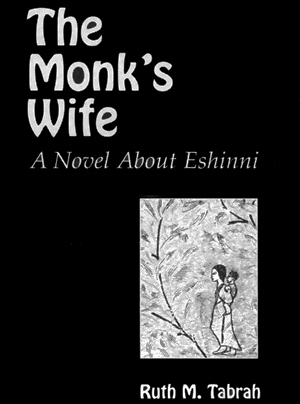 The Monk’s Wife:
The Monk’s Wife:
A Novel About Eshinni
Ruth M. Tabrah
Honolulu: Buddhist Study Center Press, 2001
257 pp.; $15.00 (paper)
Set in thirteenth-century Japan, Ruth Tabrah’s historical novel The Monk’s Wife tells the story of Eshinni, wife of Shinran (1173—1262), the former Tendai monk who founded Japan’s largest Buddhist denomination, the Jodo Shinshu (True Pure Land) School. Forced out of monastic life and exiled to the wilderness by the government for exercising religious freedom and spreading Buddhism among the lower classes, Shinran was the focus of Tabrah’s earlier novel The Monk Who Dared. Picking up the narrative with Shinran’s wife, Tabrah now delves into the life of a woman caught between competing social forces and loyalties as she attempts to reconcile Buddhist practice and daily practicalities, such as raising several children, dealing with her husband’s outcast status, and managing her inherited lands, including the genin (slaves) that come with the property.
Eshinni lived during an especially tumultuous period in Japan’s history: the old nobility system was giving way to the might of the samurai class; the traditional Buddhist schools had fossilized into powerful and dangerous ecclesiastical institutions; and famines, foreign invasions, and natural disasters threatened the nation. As the old-line Buddhist sects such as the Tendai and Shingon sought to consolidate their power by forming monastic armies and courting politicians, dissatisfied seekers began to spread new and potentially rebellious teachings throughout the country. Out of this ferment arose Dogen, founder of the Soto Zen sect, the nationalist Buddhist innovator Nichiren, and Shinran, who spread the Pure Land Buddhist teachings among all classes of society in order to offer hope to those shut out of the traditional sects. As the novel opens, Eshinni and Shinran are living in the remote province of Echigo, barely scraping out a living as Shinran continues his mission of bringing the positive message of Pure Land Buddhism to the local farmers, petty lords, and slaves. Tabrah’s book includes numerous dramatic episodes: arduous pilgrimages to escape crushing famine, threats from Vajrayana priest-warriors in the mountains, family strife, government oppression, and more.
But the heart of the book is Eshinni’s gradual spiritual awakening as her Pure Land practice deepens. The path of Jodo Shinshu is based on gratitude as the key to opening up to wisdom and compassion, embodied in the joyous expression Namu Amida Butsu (“I entrust myself to the Buddha of Boundless Light and Life”). Eshinni is already a Pure Land practitioner, but her upbringing in a noble family leaves her feeling superior to the people around her. As events unfold, Eshinni slowly moves from personal thanks for her contact with the dharma to an understanding of the need for humility and fellowship with those she’d previously considered separate and different from herself. It is a classic Mahayana development, moving from concern for one’s own enlightenment to realization of the importance of liberation for all beings.
As with The Monk Who Dared, one of the greatest strengths of The Monk’s Wife is its author’s ability to bring the world of medieval Japan alive for the contemporary reader. The difficult social and religious dance that all must participate in within a rigidly class-based culture is brought starkly to life, illustrating the need that existed for new forms of Buddhism to appear and offer relief from myriad forms of suffering. Tabrah also shows how Buddhism itself was used by many as a tool for amassing power, bringing further grief to the lives of women, the handicapped, and the lower classes.
There aren’t many works of fiction written in English that focus on Buddhism, and those with both a female author and protagonist are a true rarity. The Monk’s Wife is a welcome example that demonstrates how for centuries women struggling to manage their marriages, children, property, and social lives have maintained an authentic dharma practice. Eshinni is one of the most important women in Japanese Buddhist history, and her story holds many valuable lessons for modern practitioners. Tabrah’s book is a milestone that will help introduce this strong and intelligent Buddhist laywoman to the American public. ▼